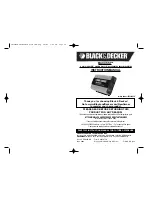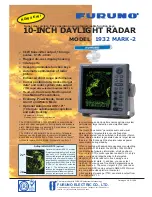
Note:
Appliance specifications may vary from brand to brand. This table is offered only as a guide to approximate
power ratings. Check appliance manuals or product labeling for actual ratings. For continuous use at
maximum output, the MAXX SST™ inverter must be connected to a DC power supply capable of providing
at least 1/10th of the inverter’s continuous wattage rating.
The inverter will operate most AC loads within its power rating. Some induction motors used in refrigerators,
freezers, pumps and other motor-operated equipment, require very high surge currents to start them. The inverter
may not be able to start some of these motors even though their rated current draw is within specifications for
this power inverter.
If a motor refuses to start, observe the battery voltage using a DC voltmeter while trying to start the motor. If the
battery voltmeter drops below 11 volts while the inverter is attempting to start the motor, this may be why the
motor won’t start. Make sure the battery connections are tight and the battery (or batteries) is (are) fully-charged.
If the connections are good and the battery is charged, but the voltage still drops below 11 volts, you may need to
use a larger battery (or battery combination).
OPERATING INSTRUCTIONS
Power Source Requirements
The inverter will operate from input voltages between 11 and 15 volts DC. If the voltage drops below 10.5 volts,
an audible low battery warning alarm will sound. The inverter will shut down if the input voltage drops below 10
volts DC. This built-in feature protects the battery from being completely discharged.
The inverter will also shut down if the input voltage exceeds 15.5 volts. This protects the inverter against
excessive input voltage. Although the inverter has built-in protection against over voltage, it may still be damaged
if the input voltage exceeds 15.5 volts.
Inductive loads, such as TVs and stereos, require more current to operate than do resistive loads with the same
wattage rating. Induction motors, as well as some TVs, may require two to six times their rated wattage to start
up. Because the MAXX SST™ inverters have a peak watt power rating, many such appliances and tools may be
safely operated. The equipment that needs the highest starting wattage are pumps and compressors that start
under load. This equipment can be safely tested. If an overload is detected, the inverters will simply shut down
until the overload situation is corrected. Use the front panel switch to turn OFF the inverter, then ON, to reset the
inverter.
CAUTION: TO REDUCE THE RISK OF PROPERTY DAMAGE:
• Exceeding recommended voltage limits will void manufacturer’s warranty.
• NEVER try to use the inverter with any 12 volt DC power source that uses a positive ground.
(Most vehicles use negative ground systems.)
Determining Battery Size
To determine the minimum battery size you will need to operate appliances from MAXX SST™ inverters, follow
these steps:
1.Determine the wattage of each appliance and/or tool you will need to
simultaneously operate from the inverter. To do this, read the labels on the equipment to be operated.
2.Estimate the number of hours the equipment will be in use between battery recharges.
3.Determine the total watt-hours of energy use, the total running time and the average power consumption.
Keep in mind that some appliances are not drawing the same power continuously. For example, a typical home-
use coffee maker draws 500 watts during brew time (approx. 5 minutes), but maintains the pot temperature at
only about 100 watts. Typical use of a microwave is only for a few minutes, sometimes at low power.
Runtime
The following graph is a set of curves that show how appliance load, in watts or in amperes, affects runtime.
These curves are only estimates of operating time, dependent upon:
• The condition of the batteries
• The state of charge on the batteries
• The amount of other DC appliances drawing current from the batteries
Three curves were developed for a battery of 50 Ampere Hours (AH) capacity, and three for multiple batteries in
parallel. The higher capacity curves are for 120 AH, 200 aH and 400 aH capacities. These large capacity batteries
clearly extend operating time at full load. To extend operating time in general, reduce the heavy appliance load to a
minimum. Remember, you are operating on stored energy and probably under power loss conditions.
Note:
All operating time curves assume permanent installation with the appropriate DC input wire (See the
“Specifications” section of this Instruction Manual) and a full charge on the batteries.
7
APPLIANCE POWER CONSUMPTION
MAXX SST™ inverters are ideal for powering:
Most electrical tools, appliances and audio/video equipment have labels that show the unit’s power consumption
in amps, watts, or both. To avoid inverter shutdown and possible damage to the inverter, avoid exceeding the
wattage rating of this unit. To obtain a rough estimate of the current (in amperes) the power source must deliver
where the power consumption of the tool or device is given in watts AC, simply divide the power consumption of
the load by 10.
Example: If a load is rated at 200 watts AC, the power source must be able to deliver: 200 divided by 10 = 20 amperes.
The inverter has built-in overload protection so that if you do exceed the inverter’s output capacity continuously,
the unit will automatically shut down. Once the excessive load is removed, the inverter can be restarted and
resume normal operation.
Note:
To restart the inverter, turn it OFF, and then ON again. The ON/OFF Switch is located on the unit’s Front
Panel (refer to the “Control and Functions” section of this Instruction Manual).
The inverter powers resistive loads the easiest; however, larger resistive loads, such as electric stoves or heaters,
could draw more wattage than the inverter can deliver on a continuous basis.
CAUTION: TO REDUCE THE RISK OF PROPERTY DAMAGE:
Ensure that total continuous power consumption of all tools and/or appliances connected to the inverter (and in
use) does not exceed the inverter’s continuous watts rating. Also ensure that start-up wattage for inductive loads
does not exceed peak watts for more than a second.
Appliances such as microwave ovens will normally draw more than their rated current and could possibly
overload the inverter when operating simultaneously with other appliances. For example: A 600 watt microwave
oven draws approximately 940 watts.
The following chart shows the approximate amperage and corresponding wattage at 120 volts AC for various
common tools and appliances.
APPLIANCE CONSUMPTION IN AMPS AND WATTS CHART
APPLIANCE
AMPS @
WATTS @
120VAC 120VAC
Laptop Computer
0.45
55
Household Power Mixer
1.83
220
240-Watt Stereo/Amplifier
2.01
242
Refrigerator
2.75
330
3/8" Variable Speed Drill
2.75
330
Variable Speed Jig Saw
2.75
330
10-Speed Blender
2.93
352
Belt Sander
3.11
374
3/8" Reversible Drill
3.20
385
Household Food Processor
3.30
396
Computer and Monitor
3.66
440
Portable Vacuum
4.21
506
8-Cup Coffee Maker
5.04
605
Electric Trimmer
5.04
605
1/2" Hammer-Drill
5.04
605
Reciprocating Saw
5.50
660
Vacuum Cleaner
6.60
792
1-1/8" Rotary Hammer
7.15
858
1/6 H.P. Submersible Sump Pump
7.33
880
Compact Microwave Oven
7.91
935
10" Bench Saw
12.50
1500
• Lights
• TVs and TV/DVD (VCR) combinations units
• Radio receivers/transceivers and stereo systems
• Computers and peripheral equipment
• Refrigerator/freezers
• Small microwave ovens
• Household appliances
• Dry and/or wet/dry vacuums
• Heavy duty power tools & chargers
• Sump pumps, motors and other electric-powered
equipment
6
90550750 VEC049DCB GOOD ONE.qxp 6/5/09 1:46 PM Page 6





































